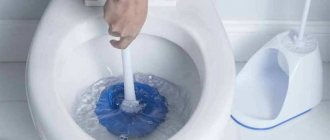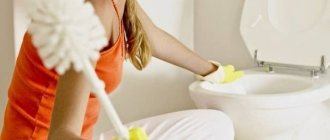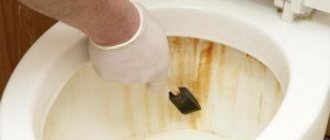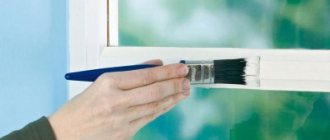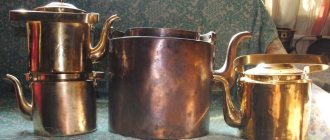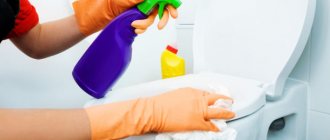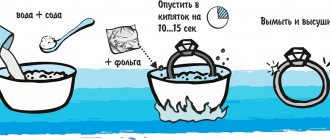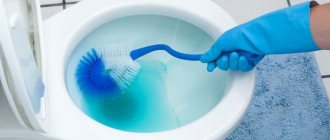After prolonged use of the toilet and improper cleaning and cleaning, deposits in the form of urinary stones appear on the walls of the toilet, rim and drain hole of the toilet. This also occurs when the tank is not drained completely or regularly, often in families with small children. As a result, mineral deposits form on the walls and bottom of the toilet.
We often have to deal with the fact that even with regular care of the plumbing, the surface of the toilet bowl darkens, rust spots and traces of limescale appear on it. How to clean the toilet from dirt yourself? How to remove urinary stone, plaque and rust? What cleaning solution or powder should I use to clean my toilet until it shines without damaging the surface? First, you need to understand how certain types of deposits are formed.
Folk remedies
You can get rid of urinary stones using folk remedies. Most are found in every home - improvised substances are no less effective than professional ones.
Vinegar
Acetic acid at a concentration of 9% dissolves urinary stones and destroys microorganisms. Heat the vinegar in a water bath, pour over the walls of the toilet and leave for six hours. Then remove any remaining dirt with a stiff brush. Pre-sprinkle local areas with heavy plaque with baking soda.
Lemon acid
Mix citric acid in powder form with water to form a thick paste, apply to contaminated areas for 3 hours and clean the bowl with a brush. Acid will also remove limescale deposits well.
Mustard
The powder enhances the effect of other substances. How to remove urinary stone from a toilet:
- mix 2 tbsp. mustard with 2 tbsp. citric acid and 4 tbsp. starch;
- add water until a homogeneous paste forms;
- Spray the toilet with the mixture and leave for at least 30 minutes;
- remove deposits with a brush or stiff sponge.
Coca-Cola or Sprite
These drinks contain phosphoric acid. Despite the small concentration, it is enough to combat urinary stones and limescale. Pour 1.5 to 3 liters of Coca-Cola or Sprite into the toilet overnight, and flush with water in the morning.
Soda
To remove mineral deposits and dirt, sprinkle powder onto problem areas and leave for 8-10 hours, then rinse with water. This way you will not only get rid of plaque, but also update the appearance of your plumbing fixtures, since soda brightens the surfaces.
Preparing for the removal process
To make the process of removing urinary stones faster, it is necessary to carry out a number of preparatory measures:
- Collect the necessary equipment . Cleaning the toilet is impossible without a brush, a hard sponge, a basin of clean water, and a ladle. It is important to remember that a huge number of germs and bacteria accumulate under the headband, so it is necessary to take care in advance to protect your hands, respiratory tract, and clothing.
- Choose a cleaning product . It is better to start the process of removing urinary stones with the most gentle and safe means at hand for human health. If it was not possible to remove the yellow plaque the first time, more aggressive chemical compounds will come to the rescue.
- Remove water from the toilet . Armed with rubber gloves and a ladle with a long handle (alternatively, you can use an old ladle, a jar, or a large syringe), scoop out all the liquid from the toilet. Ignoring this preparation point significantly reduces the quality of cleaning plumbing.
- Degrease contaminated surfaces . Before applying any cleaning composition, the walls of the toilet bowl are treated with liquid detergent, then rubbed with a brush and drained with clean water.
In order to prevent water from entering the cleaning agent during the cleaning process, it is necessary to turn off the tap located near the tank in advance.
Household chemicals
If available means do not help, use household chemicals: manufacturers offer various compositions to effectively combat mineral deposits on plumbing fixtures.
Domestos gel Pink
The gel removes dense limescale and urinary stones, destroys microbes. Thanks to its thick consistency, it stays on vertical surfaces for a long time and dissolves dirt even under water. Country of origin: Hungary. Price for a 750 ml bottle - from 150 rubles.
Cillit
The product contains oxalic acid, which destroys mineral and organic deposits of all types. The gel also copes well with rust stains. The manufacturer offers a line of compositions with different effects: whitening, getting rid of rust, limescale. It works within a minute, but for the best effect, leave it on the surface for 30 minutes and rinse with water. Country of origin: Russia. Price for a 750 ml bottle - from 130 rubles.
Toilet duckling
Gel with 5–15% hydrochloric acid, which fights mineral deposits and microorganisms. The special feature is the curved spout of the bottle. It allows you to apply the composition to hard-to-reach places, for example, under the rim of a toilet bowl. Country of origin: Russia. Price for a 950 ml bottle - from 100 rubles.
Comet
Comet gel is specially formulated to remove mineral deposits and rust. The multi-jet dispenser quickly and evenly distributes products over the entire surface. After application, wait 15 minutes, then remove dirt with a stiff brush. Country of origin: Russia. Price for a 750 ml bottle - from 120 rubles.
Sanox gel
The product contains citric and oxalic acids. They ensure not only the destruction of mineral, but also fatty deposits. Sanox gel is positioned as effective protection against the proliferation of intestinal pathogens and staphylococcus. Price for a 750 ml bottle - from 140 rubles.
How to clean a child's potty from plaque
If you wash the pot thoroughly immediately after using it for its intended purpose, then no plaque will have time to form.
If it has formed, then Domestos cleans it up quite well. It is also good for disinfection. The pot should be disinfected periodically, so I am for Domestos. The main thing is to wash it off thoroughly afterwards, it still contains chemicals.
trembling doe
I found an interesting way to clean a child’s plastic potty from plaque. If you pour water into it that has just boiled in a kettle, then the high temperature will cause the plastic to begin to expand, and the plaque will bounce off the walls.
trembling doe
There is an excellent tool, quite inexpensive. Sold in almost all hardware stores. It's called Chistin. Turns urinary stone into jelly and is easily washed off with a stream of water. Eliminates the problem of scraping. Does not damage the surface, even plastic.
I asked myself this question and researched Google. What I tried: Domestos, Sanox, whiteness, duckling for cleaning toilets - the result was little. The following recipe helped:
lemon acid. Sprinkle the whole bag evenly over the stone at the bottom of the pot. boiling water. Pour boiling water to the point where the urinary stone deposit ends. leave for about a couple of hours. Then scrub the stone with a stiff brush (possibly with force). Be sure to clean the pot with gloves, because the acid is very concentrated and burns the skin on your hands.
It helped me. I hope this method will help you too. The recipe is also suitable for cleaning plastic cat litter.
Nastya Khokhlova
I poured just a little Titan detergent into the pot, let it sit for about five minutes, and then used a brush to clean off the deposits. Afterwards, rinsed thoroughly with warm running water. There is no residue left and no odors (urine or product). The product does not change color.
Galina Vasilna
If you not only rinse the pot, but also wipe it dry with a good cloth, it will shine and there will be no deposits. But if it’s already sunken, you can rub it with baking soda and then moisten it with vinegar. The plaque will soften, part of it will fly off on its own and rub the rest with a washcloth.
Rose of the World
You can use any product that is used to clean toilets. Only after it will you need to thoroughly rinse the pot to completely remove the product. The plaque will disappear. To prevent it from appearing again, wash the pot thoroughly.
Potent acids
Strong acids are used to remove multilayer deposits. But it is important to observe dosages and precautions: too high a concentration of substances can damage enamel and plastic pipes. Acid corrodes skin and mucous membranes, so use rubber gloves, a respirator and safety glasses when working. This cleaning method cannot be used often, otherwise over time the aggressive agent will ruin the toilet bowl.
If you don’t want to take risks, turn to professionals: experienced cleaners will select chemicals specifically for sanitaryware and perfectly clean the surface.
Orthophosphoric acid.
The substance does not destroy polymers, therefore it is safe for plastic pipes. But at the same time it dissolves rust and any plaque well. Directions for use: pour about 150 g of the substance into the toilet bowl, spread it with a brush under the rim and along the walls. Close the lid and leave for 15 minutes. After this, clean with a brush or brush and drain the water.
Oxalic acid.
Oxalic acid is sold in hardware stores in the form of a white powder. It can be used dry or slightly diluted with water. Apply the product to a damp sponge, treat the surface and leave for an hour. Then use a brush and drain the water.
A solution of soda and vinegar to remove urinary stones from the toilet
This method is intended for cleaning larger lesions.
It is worth noting that it is slightly different from the previous one. The peculiarity is that the toilet does not need to be dried; on the contrary, flushing will be useful here. The fact is that for effective cleaning the structure must remain slightly damp.
As with the previous case, everything is done in several steps:
- Sprinkling soda on the wet walls of the toilet. It’s worth taking the whole pack to make the method more effective. After this, leave the resulting porridge for two or three hours.
- Preparation of inventory.
- Preparation of vinegar solution. It also doesn't need to be heated too much.
- Spraying liquid onto the coating. Then you need to wait about one hour.
- When finished, remove any remaining product and wash the structure with soap or a special solution.
It should be said that this case is a little more complicated than the first, but its effectiveness is much greater. Of course, it is not advisable to choose it when the deposits are small.
Checklist for cleaning the toilet
Cleaning a toilet is a multi-step process, check yourself with this checklist. Need to:
- use household products twice a week and leave them on the surface for 10–15 minutes;
- once a week, treat the area under the toilet rim with a special curved brush, disinfect the outside of the rim;
- once a month, pour bleach or vinegar into the tank to remove limescale if you do not use water softeners;
- Disinfect the outside of the toilet once every two months.
Prevention measures
Several rules will help you maintain perfect cleanliness of the plumbing in the toilet
- Regular cleaning. The toilet needs to be cleaned not when an impenetrable layer of urine and limestone has accumulated on its walls, but every day
- Using tablets for the tank. Special tablets that soften the water in the toilet tank prevent the growth of urinary deposits on the walls of the toilet.
- Checking the serviceability of the drain tank. It is important to prevent water from leaking from the tank. Otherwise, a yellow coating and rusty stains will very quickly appear on the walls of the toilet.
Just ten minutes a week spent on preventing the appearance of urinary stones will save several hours needed to completely remove stubborn stains.
Tips and warnings
In order for the animal not to stop going to the toilet, it is necessary to follow some tips and recommendations depending on the characteristics of the animal.
Castration
Neutered cats have more potty requirements. Animals require larger toilets. Preference should be given to toilets with mesh. Since ordinary trays can be uncomfortable for cats.
How to choose a filler
The filler should not contain any foreign odors. The most commonly used filler is wood or clay. In order to choose the right one, you need to try species until the animal determines the most suitable one. You should not skimp on the filler; the better the substance absorbs moisture, the less germs and unpleasant odors are formed. Cheap litters quickly require replacement and often do not absorb urine at all.
How often should you change the tray?
The device must be changed once a year. Even with frequent cleaning, the material absorbs an unpleasant odor and can repel the animal.
Choosing a time to clean
Many cats visit the litter box at certain times. Therefore, it is necessary to change the litter when the animal does not visit the toilet. In the absence of filler, the cat can go anywhere, thereby causing trouble for the owner.
Toxoplasmosis
To avoid contracting toxoplasmosis, you must use a respirator. This device is inexpensive, but allows you to protect the respiratory organs. A new respirator must be used before each fill change.
Location of problems
Limescale in the kitchen
The sink, faucet, splashback and kitchen appliances are the main items in the kitchen that are susceptible to lime deposits.
Important: use household chemicals to clean these items only that are non-toxic and absolutely safe for human health. Ceramic surface and tiles
Ceramic surface and tiles
Requires cleaning with mild, non-abrasive cleaning agents. After cleaning, completely remove any remaining cleaning product. To prevent the appearance of limescale, wipe the tiles and stove with a warm soapy solution.
Plastic products
To avoid damaging or scratching plastic surfaces, use mild, non-abrasive cleaning agents.
Bathroom
Tile. Limescale deposits on the tiles make their appearance unattractive. It loses its shine and smoothness. A gel-like product will help remove limescale from the tiles. After cleaning, wash off any remaining product from the tiles and wipe dry with a cloth.
Glass and mirrors. You can clean glass and glass surfaces using sprays.
Important: it is forbidden to use cleaning products with abrasive particles, they can leave scratches on the surface.
Cranes. Powdered products are not suitable for cleaning chrome finishes. They leave scratches and cloudy stains on the surface. After cleaning, wipe the surface with a soft, lint-free cloth.
Toilet. Special products and the use of a brush will help remove plaque from the toilet.
Location of problems
Limescale in the kitchen
The sink, faucet, splashback and kitchen appliances are the main items in the kitchen that are susceptible to lime deposits.
Ceramic surface and tiles
Requires cleaning with mild, non-abrasive cleaning agents. After cleaning, completely remove any remaining cleaning product. To prevent the appearance of limescale, wipe the tiles and stove with a warm soapy solution.
Plastic products
To avoid damaging or scratching plastic surfaces, use mild, non-abrasive cleaning agents.
Bathroom
Tile. Limescale deposits on the tiles make their appearance unattractive. It loses its shine and smoothness. A gel-like product will help remove limescale from the tiles. After cleaning, wash off any remaining product from the tiles and wipe dry with a cloth.
Glass and mirrors. You can clean glass and glass surfaces using sprays.
Cranes. Powdered products are not suitable for cleaning chrome finishes. They leave scratches and cloudy stains on the surface. After cleaning, wipe the surface with a soft, lint-free cloth.
Toilet. Special products and the use of a brush will help remove plaque from the toilet.
What to do if your cat refuses to go to the litter box
If the cat refuses to go to the litter box, it is necessary to do an analysis and find out the reason for this refusal. Very often, pets may refuse to go to the toilet for the following reasons:
- The cat does not accept the litter box. To solve this problem, you need to replace the product with a new one.
- The cat doesn't like the litter. Many pet owners use clay, but this may not suit the pet. Therefore, you need to try changing to an odorless wood one.
- The animal's toilet is located in a noisy place; it is necessary to move the tray to a quiet place, if possible to the place where the animal prefers to go to relieve itself.
- If the cat went to the toilet in the wrong place, it is necessary to thoroughly clean it using special detergents with the addition of chlorine.
Cats are very demanding animals and can sometimes react negatively to any changes. This includes improper placement of the toilet.
Important. If you do not promptly clean the place where the cat has pooped, the animal will go there regularly until a general cleaning is carried out.
Why does yellow plaque appear on the toilet?
Regular tap water contains large amounts of minerals. They tend to linger on the surface of plumbing fixtures. Especially if it is made of low-quality material. Then the surface of the toilet becomes rough and it is easier for deposits to attach to the ceramics. Therefore, at the time of purchase, it is necessary to check the surface of the product so that it is as smooth as possible.
Before deciding how to remove limescale from the toilet, you should understand that it is not only water that causes it to appear. After all, minerals are also found in urine. Therefore, urinary stone deposits appear on plumbing fixtures. The main thing in the fight against yellowness on toilet ceramics is to carry out cleaning in a timely and efficient manner. Since prevention will extend the service life of plumbing fixtures.
